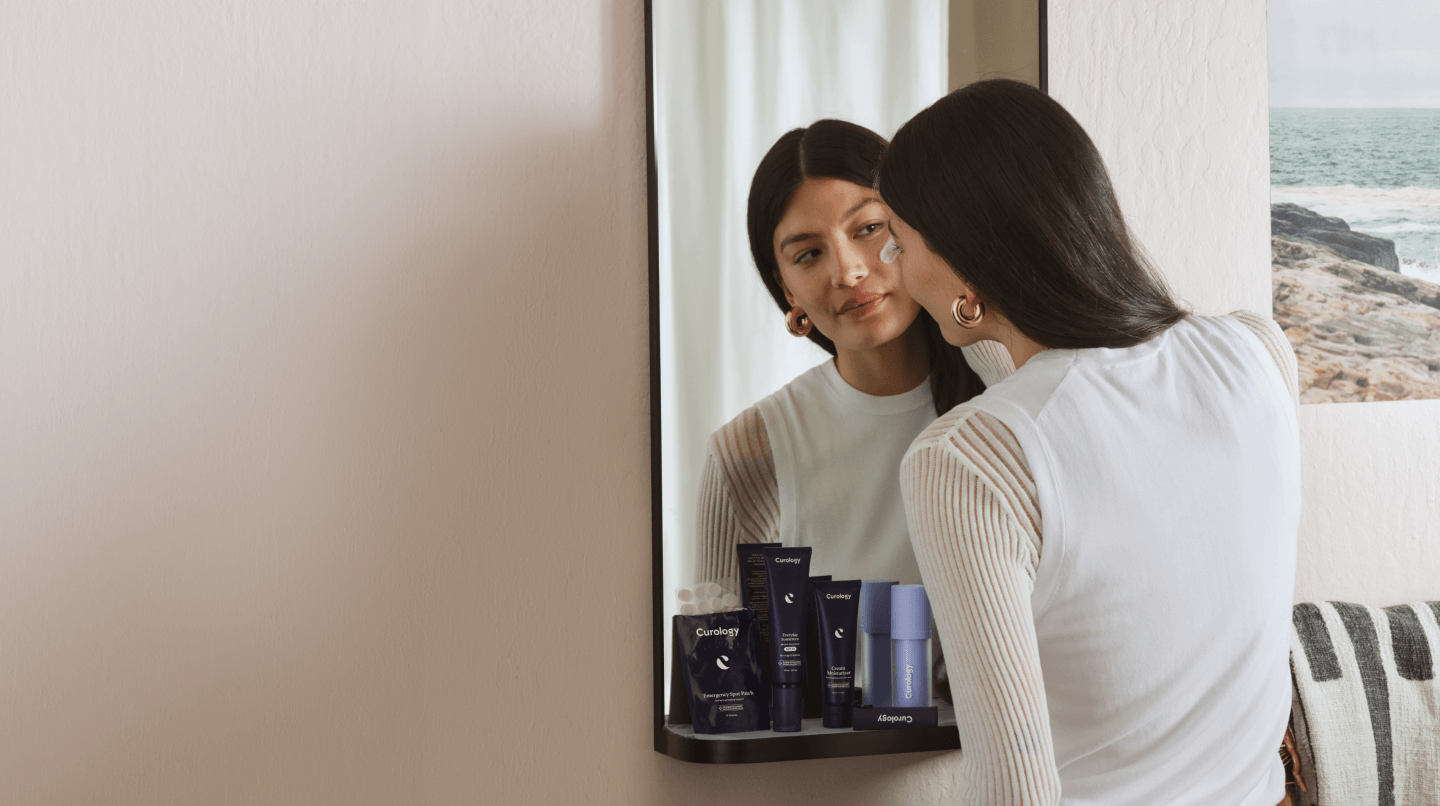How it works:
Share your skin goals and snap selfies
Your dermatology provider prescribes your formula
Apply nightly for happy, healthy skin
How it works:
How it works:
Share your skin goals and snap selfies
Your dermatology provider prescribes your formula
Apply nightly for happy, healthy skin
How it works:
Ask an expert: How to prevent wrinkles
Every wrinkle has a story—but if you prefer to keep it to yourself, here’s how to prevent wrinkles.



Fine lines and wrinkles are a normal part of life as you get older. We say there's nothing to hide or feel ashamed about—everyone gets them! That said, we understand if you’d prefer to minimize their appearance. Prevention is key, and deep wrinkles can be a bit more challenging to treat when compared to fine lines. To give you the best advice, we’ll dig into the different types of wrinkles, and what may cause them. Our team of skincare experts will also share some common skin myths to watch out for (like not needing to wear sunscreen every day!) that may work against your best anti-aging efforts.
If you’re wondering how to prevent wrinkles, it’s important to remember: We can’t stop aging, but we can certainly help slow some signs of it.
Fine lines vs. wrinkles: What’s the difference?
Fine lines can happen if you repeatedly contract the same facial muscles over time.¹ Eventually, these fine lines can develop into deeper wrinkles. Dynamic lines, also called rhytides, come from repeated muscle movement. You may see them on your forehead, around your eyes (crow’s feet), and between your eyes. Signs of aging, including wrinkles, don’t happen overnight, but they’re associated with a reduction of collagen and elastin in the skin,² which may cause a loss of firmness. Collagen forms the skin’s support structure, and elastin helps the skin bounce back.
What causes wrinkles and sagging skin?
Aging is a natural process that inevitably involves skin changes and wrinkles. We may be able to slow these changes, but we can’t stop them entirely. And no two wrinkles are alike—aging progresses differently for everyone.
Causes of skin aging are typically divided into two categories: intrinsic and extrinsic. Intrinsic aging is caused by factors beyond your control, such as genetics and the passage of time.³ Extrinsic aging is impacted by lifestyle factors, such as smoking, sun exposure, diet, and stress.⁴ The primary extrinsic factor is the sun’s UV rays.⁵
Expert tips to help prevent wrinkles
Wondering how to prevent wrinkles on the forehead and other areas? Unfortunately, there’s no magic solution. Although we can’t completely stop them from forming, there are things you can do to help slow their progression and retain a more youthful appearance. Here are a few tips for minimizing and preventing wrinkles:
Avoid direct sunlight
We’ll say it again and again (and again): Sunscreen is your top defense against wrinkles and other signs of aging.⁶ For the best results, reapply a broad-spectrum sunscreen like Curology’s, which contains an SPF 30 formula that’s non-comedogenic and non-greasy, every two hours, and wear a hat, sunglasses, and clothing to cover exposed skin.
Use retinoids
Retinoids can be a great addition to your anti-aging skincare routine. Over-the-counter options like Adaplene can help, as can tretinoin, available by prescription only. Tretinoin boosts collagen production and skin cell turnover. This may help slow wrinkle formation and improve existing wrinkles and fine lines.⁷ Many dermatologists consider tretinoin the gold standard for anti-aging skincare, although more research is needed to determine its effect on deep wrinkles.⁸
In case you were wondering, tretinoin is available at Curology. Consult your licensed Curology dermatology provider to see if tretinoin is right for you—or sign up for a free consultation.
Consider Botox
Botulinum toxin (Botox) can’t stop the aging process, but it may help reduce its appearance.⁹ Studies show that regular Botox injections may reduce the signs of aging by helping manage certain dynamic facial lines and wrinkles. Botox is best for targeting the primary cause of dynamic lines, such as frown lines, glabellar lines, and crow’s feet.¹⁰
Eat a healthy diet
Eating a well-balanced diet filled with fresh fruit, vegetables, lean protein, and whole grains may help slow signs of aging. Research shows that consuming higher quantities of red meat and savory snacks may be associated with more facial wrinkles, whereas a fruit-dominant diet may be associated with fewer lines.¹¹ Opt for healthy, whole foods, and keep processed foods and sugar to a minimum.
Avoid alcohol
Happy hour can be fun, but those after-work drinks may come at a price. Alcohol may damage and dehydrate the skin, speeding up the visible signs of aging and making you look older.¹² Mocktails are just as delicious, and they don’t come with a hangover the next day.
How to reduce wrinkles on your face, neck, and chest

Specific vitamins can help improve the skin’s appearance, including vitamin C, which is a powerful antioxidant that may boost collagen production.¹³ A study showed that the topical application of vitamin C on mild to moderately photo-damaged skin significantly improved fine lines, skin tone, and roughness.¹⁴ Vitamin A (aka retinol) is another potential ally in the fight against wrinkles. The active ingredient in tretinoin, vitamin A may help reduce the appearance of fine lines, wrinkles, roughness, and hyperpigmentation when applied topically.¹⁵
We’re also often asked how to prevent wrinkles under the eyes. Because the skin around the eyes is more delicate,¹⁶ treating it with extra care is key. Always touch the skin around your eyes gently (avoid rubbing!) and consider using products specifically designed for this area.
Don’t believe these wrinkle myths
When it comes to busting skincare misconceptions, you can trust our dermatology experts. They’ve given us the inside scoop on wrinkle myths, and the facts might surprise you. Here are a few common myths about wrinkles that just aren’t true:
Wrinkles are entirely hereditary
You may have inherited your parents’ warm laugh and weird toes, but their wrinkles? Not as likely. While genetics play a role in wrinkle development, the idea that we have no control over them is simply inaccurate. Extrinsic factors may have a much more significant impact on your skin.
There’s only one skincare routine that works
Everyone is unique, so different skincare routines will work for different people. Figuring out what works best for you takes time, effort, trial, and error. Start by using products made with proven effective ingredients, and if you’re on the hunt for your skin’s perfect anti-aging lineup, test one product at a time to avoid irritation.
You only need sunscreen when it’s sunny
If you break out the SPF lotion when it’s sunny but skip that step when the weather’s less than stellar, you’re still leaving your skin open to damage from UVA and UVB rays, plus a higher risk of skin cancer. Sunscreen is super important, even on overcast days and when you’re indoors near windows. If you prefer how you look with a sunkissed glow, reach for a sunless tanner.
Affordable and effective wrinkle treatments
Reducing the appearance of fine lines and wrinkles doesn’t have to break the bank, and Curology provides an excellent example! Curology’s HydroTretᴿˣ. helps smoothen texture and lessen the appearance of fine lines while giving you healthy, glowing skin. The all-in-one prevention treatment is customized by one of our in-house licensed dermatology providers with prescription-strength ingredients (like tretinoin) to target the signs of aging, including fine lines and wrinkles, boost collagen production, fade hyperpigmentation, and smoothen the skin’s surface. Safe for all skin types, Curology’s HydroTretᴿˣ is for anyone who wants to maintain clear skin, while also preventing the earliest signs of aging.
Smooth wrinkles with Curology

If you’re looking for effective skincare to treat acne or signs of aging (including hyperpigmentation), we’ve got you. If Curology is right for you, we’ll pair you with a licensed, in-house dermatology provider to get started—just snap a few selfies so we can get to know your skin a little better. Our providers can work with you to create a custom prescription treatment plan that includes potent active ingredients, such as tretinoin, that can help improve existing wrinkles and slow the progression of new ones.
We also offer advice for keeping your skin healthy to help you reach your skin goals; we want to help you tackle your skincare concerns! Complete your routine with our full line of non-comedogenic, dye-free, paraben-free, and hypoallergenic skincare products, all made to keep your skin happy and healthy.
Ready to get started? Start your Curology journey now.
FAQs
Fine lines can happen if you repeatedly contract the same facial muscles over time. Eventually, these fine lines can develop into deeper wrinkles. Dynamic lines, also called rhytides, come from repeated muscle movement. You may see them on your forehead, around your eyes (crow’s feet), and between your eyes.
Aging is a natural process that inevitably involves skin changes and wrinkles. We may be able to slow these changes, but we can’t stop them entirely. And no two wrinkles are alike—aging progresses differently for everyone.
P.S. We did the homework so you don’t have to:
11 Ways to Reduce Premature Skin Aging.American Academy of Dermatology. (n.d.).
Wong, Q., Chew, F. Defining skin aging and its risk factors: a systematic review and meta-analysis. Scientific Reports. (2021).
Farage, M. A., et al. Intrinsic and Extrinsic Factors in Skin Ageing: A Review.International Journal of Cosmetic Science. (2008).
Farage, M. A., et al. Intrinsic and Extrinsic Factors in Skin Ageing: A Review.International Journal of Cosmetic Science. (2008).
Poljšak, B., et al., Free Radicals and Extrinsic Skin Aging. Dermatology Research and Practice. (2012, February 29).
11 Ways to Reduce Premature Skin Aging.American Academy of Dermatology. Ibid.
Mukherjee, S., et al. Retinoids in the treatment of skin aging: an overview of clinical efficacy and safety. Clin Interv Aging. (2006).
Manriquez, J., et al. Wrinkles.Clinical Evidence. (December 2014).
Manriquez, J., et al. Wrinkles.Clinical Evidence. Ibid.
Ganceviciene, R., et al. Skin anti-aging strategies.Dermatoendocrinol. (2012)
Jacobs, L., et al. A healthy diet in women is associated with less facial wrinkles in a large Dutch population-based cohort.Journal of the American Academy of Dermatology. (2019).
11 Ways to Reduce Premature Skin Aging.American Academy of Dermatology. Ibid.
Fitzpatrick, R., et al., Double-Blind, Half-Face Study Comparing Topical Vitamin C and Vehicle for Rejuvenation of Photodamage. Dermatologic Surgery. (2008).
Traikovich, SS., Use of topical ascorbic acid and its effects on photodamaged skin topography. Arch Otolaryngol Head Neck Surg. (1999)
Keller, K., Fenske, N. Uses of vitamins A, C, and E and related compounds in dermatology: A review. Journal of the American Academy of Dermatology. (1998).
New biological insights into skin aging around the eye.J Am Acad Dermatol. (2016).
Donna McIntyre is a board-certified nurse practitioner at Curology. She obtained her Master of Science in Nursing at MGH Institute of Health Professions in Boston, MA.

Curology Team

Donna McIntyre, NP-BC
Related Articles
Is washing your face making your acne worse? Ask an expert25 skincare myths debunked: what you need to knowAsk a skin expert: Your skin’s damaged skin barrierPotential side effects of vitamin C: What you need to knowWhat’s causing your skin irritation and how to stop itPopular Articles
Ask Curology: Is my cold breaking me out?Slugging: The dermatologist-approved skincare hack going viral on TikTokTretinoin vs retinol: What’s the difference?How to create a self-care routine that actually sticksYour 2023 skincare horoscopeTry prescription skincare
Get routine essentials


Face what’s next with Future-ProofRx
Face what’s next with Future-ProofRx
- Skin texture
- Fine lines
- Wrinkles
- Dark spots
- Dullness
$29.95/month